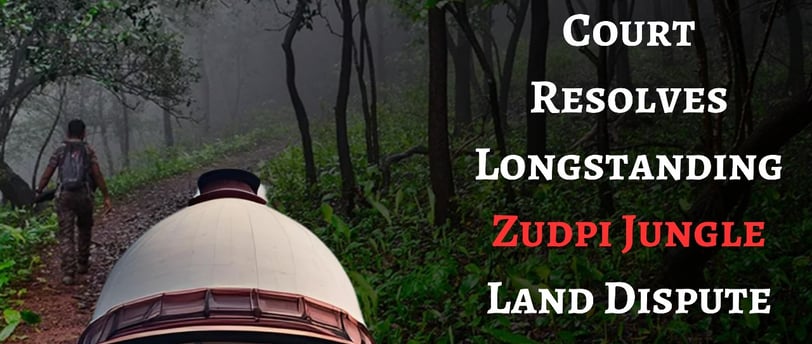Supreme Court Resolves Longstanding Zudpi Jungle Land Dispute in Maharashtra.
In a landmark ruling, the Supreme Court of India has brought closure to a decades-long dispute surrounding the classification and usage of "Zudpi Jungle" lands across six districts in the Vidarbha region of Maharashtra. The Court, led by Chief Justice B.R. Gavai, accepted the recommendations of the Central Empowered Committee (CEC) detailed in its 2025 report, balancing environmental considerations with socio-economic realities
5/26/20253 min read


Background and the Dispute
The term “Zudpi,” a Marathi word meaning bushes or shrubs, has historically referred to inferior types of unoccupied lands bearing bushy growth. These lands, predominantly located in Nagpur, Wardha, Bhandara, Gondia, Chandrapur, and Gadchiroli districts, were recorded as forests under the British-era revenue records despite lacking the ecological attributes of forest land.
Over decades, these Zudpi lands have been used for various non-forest purposes, including the construction of schools, hospitals, roads, government offices, and agricultural activities. However, due to an administrative oversight and lack of updated revenue records, they continued to be listed as forest lands, bringing them under the purview of the Forest (Conservation) Act, 1980 (FCA).
The issue gained national prominence following the Supreme Court's 1996 ruling in the Godavarman case, which interpreted the term "forest" broadly, thereby extending FCA protections to any land recorded as forest, regardless of actual forest cover.
State Government’s Plea
Facing severe developmental constraints and legal hurdles, the State of Maharashtra filed IA No.12465 of 2019, requesting the Court to declare that 86,409 hectares of Zudpi Jungle land, unfit for forestry, should not fall within the FCA’s ambit. The State contended that these lands had long been in use for public purposes and that further restrictions would adversely impact millions of residents.
In support, the State presented findings from several committees—including the Mahajan and Joshi Committees, and a High Powered Committee (HPC)—which concluded that a significant portion of the land lacked forest characteristics and was unsuitable for forest management.
Opposition and Interventions
Environmental concerns were raised by intervenors like Prasad Khale, who argued that Zudpi lands played an essential role in ecological balance and biodiversity. Senior Counsel Madhavi Divan, representing the intervenors, criticized the 2025 CEC Report for overlooking wildlife presence and emphasized the risks of degrading scrub forests through de-notification.
CEC Reports and Findings
Following Court directives, the Central Empowered Committee submitted two crucial reports—the 2019 and 2025 CEC Reports. The CEC undertook an extensive verification exercise, examining over 141 GB of data and conducting field visits across the affected districts.
Key findings from the CEC included:
Zudpi lands should be treated as forest lands under FCA.
Non-forest use prior to 12.12.1996 (the date of the Godavarman ruling) may be regularized via consolidated proposals from the State.
No compensatory afforestation or NPV (Net Present Value) would be required for such regularized land uses.
Post-1996 non-forest use and encroachments must be dealt with strictly, and violations must be penalized.
The CEC also stressed the need to protect “fragmented” land parcels under 3 hectares by declaring them protected forests and preventing future encroachments or commercial usage.
Supreme Court’s Ruling
Accepting the 2025 CEC Report in full, the Supreme Court ruled:
"The Zudpi Jungle lands shall be considered as forest lands for all purposes, and the Forest (Conservation) Act, 1980, is applicable. However, given the unique history and socio-economic implications, a pragmatic and non-precedent approach is warranted."
The Court permitted the Maharashtra government to submit consolidated proposals for regularizing pre-1996 non-forest usage. It also directed the Centre and State to create a simplified procedure for processing such proposals and assigned monitoring responsibilities to the CEC.
Further, the Court mandated that all encroachments and illegal commercial use post-1996 be addressed within two years through specially constituted task forces in each district. Rights under the Forest Rights Act, 2006, were to be processed with satellite imagery support.
Socio-Economic Justice and Constitutional Balance
Significantly, the Court framed the judgment within the broader constitutional mandate of social and economic justice, as enshrined in Articles 38 and 39 of the Constitution. It noted:
“Lakhs of citizens—slum dwellers, farmers, students—are at risk of displacement if the pragmatic approach of the CEC is not adopted.”
The judgment underscored that denying legitimacy to long-settled uses of the land would result in the demolition of government buildings, health centers, schools, and even strategic installations like defence outposts.
Implications and Way Forward
This judgment marks a watershed in India’s environmental jurisprudence by:
Reaffirming the importance of sustainable development.
Prioritizing forest conservation, while recognizing the historical and developmental context of Zudpi Jungle lands.
Providing a model of cooperative federalism and expert-led decision-making.
The verdict is expected to unlock thousands of pending infrastructure and welfare projects across Eastern Vidarbha, while simultaneously enforcing strict environmental compliance on future land use changes.
Conclusion
The Supreme Court’s nuanced approach in balancing ecological integrity with human development in the Zudpi Jungle lands case reflects a maturing constitutional environmentalism. It sets a precedent not in substance, but in process—a careful, fact-based and compassionate adjudication respecting both nature and people's livelihoods.
